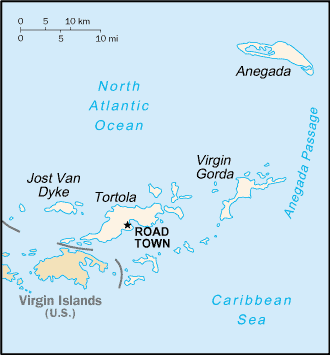Nationality:
noun: British Virgin Islander(s) adjective:British Virgin Islander

Ethnic groups:
black 82%, white 6.8%, other 11.2% (includes Indian and mixed) (2008)

Languages:
English (official)

Religions:
Protestant 84% (Methodist 33%, Anglican 17%, Church of God 9%, Seventh-Day Adventist 6%, Baptist 4%, other 15%), Roman Catholic 10%, Jehovah's Witnesses 2%, other 2%, none 2% (1991)

Population:
32,680 (July 2014 est.)country comparison to the world: 216

Age structure:
0-14 years:17.2% (male 2,770/female 2,861)15-24 years:14.5% (male 2,252/female 2,472) 25-54 years:49.8% (male 7,697/female 8,574) 55-64 years:10.6% (male 1,709/female 1,763) 65 years and over:7.6% (male 1,258/female 1,324) (2014 est.)

Median age:
total:35.6 yearsmale:35.5 years female:35.7 years (2014 est.)

Population growth rate:
2.36% (2014 est.)country comparison to the world: 36

Birth rate:
10.83 births/1,000 population (2014 est.)country comparison to the world: 180

Death rate:
4.93 deaths/1,000 population (2014 est.)country comparison to the world: 191

Net migration rate:
17.69 migrant(s)/1,000 population (2014 est.)country comparison to the world: 4

Urbanization:
urban population:40.6% of total population (2011)rate of urbanization:1.48% annual rate of change (2010-15 est.)

Major urban areas - population:
ROAD TOWN (capital) 10,000 (2011)

Sex ratio:
at birth:1.05 male(s)/female0-14 years:0.97 male(s)/female 15-24 years:0.91 male(s)/female 25-54 years:0.9 male(s)/female 55-64 years:0.92 male(s)/female 65 years and over:0.95 male(s)/female total population:0.93 male(s)/female (2014 est.)

| | Infant mortality rate:
total:13.45 deaths/1,000 live birthscountry comparison to the world: 118 male:15.31 deaths/1,000 live births female:11.49 deaths/1,000 live births (2014 est.)

Life expectancy at birth:
total population:78.29 yearscountry comparison to the world: 57 male:76.99 years female:79.66 years (2014 est.)

Total fertility rate:
1.25 children born/woman (2014 est.)country comparison to the world: 219

Drinking water source:
improved:urban: 98% of population rural: 98% of population total: 98% of population unimproved: urban: 2% of population rural: 2% of population total: 2% of population (2010 est.)

Sanitation facility access:
improved:urban: 97.5% of population rural: 97.5% of population total: 97.5% of population unimproved: urban: 2.5% of population rural: 2.5% of population total: 2.5% of population (2012 est.)

HIV/AIDS - adult prevalence rate:
NA

HIV/AIDS - people living with HIV/AIDS:
NA

HIV/AIDS - deaths:
NA

Education expenditures:
4.4% of GDP (2010)country comparison to the world: 96

Literacy:
definition:age 15 and over can read and writetotal population:97.8% male:NA female:NA (1991 est.)

School life expectancy (primary to tertiary education):
total:15 yearsmale:15 years female:16 years (2009) |

















